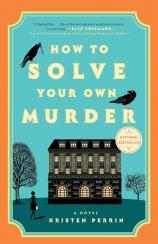Reading Group Guide
Discussion Questions
How to Solve Your Own Murder

Note: These discussion questions contain some spoilers! We suggest you finish the book before you read through them.
1. Did you have a suspect in Frances’ murder initially? How did your guesses change as the novel progressed? Were you surprised by the ultimate reveal?
2. Annie is an aspiring mystery writer and a contemplative thinker. Early in the book, she muses, “If I were writing this as a novel, Elva’s decision not to call the police would be flagged as suspicious behavior.” How does Annie’s vivid imagination both help and hinder her? How does her analytical mind ultimately point her towards the truth?
3. Names play a significant role in HOW TO SOLVE YOUR OWN MURDER? Frances is told the bird will betray her, and she has friends called Sparrow and Crane. Laura is named for Emily’s missing sister. In what ways do names point towards important clues in the novel and, alternatively, how do they serve as red herrings?
4. The author explores the distinction between imitation and envy, and how the latter can curdle into obsession. Although Emily appears to flagrantly fashion herself after Frances, Rose’s heated emotions are often in the background. Did you pick up on Rose’s strong feelings? In what ways can we see them manifest?
5. Emily is arguably the most multifaceted character in the novel, observed by her friends as a liar, a slut, a schemer, the glue that holds the group together, and the victim of emotional abuse. Ultimately Emily reveals to Frances that her schemes have a single motivation: She wants to be loved. How much do you think can be forgiven, when it comes to Emily’s actions, and how much do you hold her responsible for?
6. Games and puzzles figure prominently in the book. Frances notes in her diary: “I’ve never been very good at games.” Yet Frances goes on to spend the rest of her life working out what happened to Emily and trying to puzzle out what she sees as her own inevitable murder. In what other ways do games and puzzles figure into the characters’ lives?
7. Both Frances and Annie carefully observe the attire of those around them, and they note the way clothes can often serve as costume, transforming the way we see ourselves (wearing Jenny’s castoff dress makes Annie feel like “someone new”) and how we are seen. It can also be a camouflage, whether to take on someone else’s identity or obscure a pregnancy. How does clothing serve to both obscure and reveal truths about characters in this novel?
8. The natural world of the novel has a dangerous side. Roses are beautiful but potentially lethal. Herbs and plants can be treacherous: poisonous hemlock can be mistaken for an innocuous cow parsley, and a thriving marijuana crop supports a family but could lead to its downfall. How does the author mirror this beautiful-dangerous dichotomy in her characters as well?
9. Do you believe, as Frances did, that her murder was fated, or do you think it’s an unlucky coincidence? Or do you believe that Frances’ sleuthing to try to uncover her murderer is what actually put her in more danger throughout her life?
10. Shortly after Annie discovers Frances’ body, she “feels with full force that this isn’t a just a story, a murder isn’t just a puzzle. It’s a selfish, final, complex act.” By the end of the novel, she recognizes, “My own story is a living thing. It unfolds and turns and folds over itself again. When you write it all down, you can go back and find meaning you’d never noticed was there all along.” Discuss the ways the characters, both past and present, create and inhabit their own stories, and how their versions may differ from reality.







